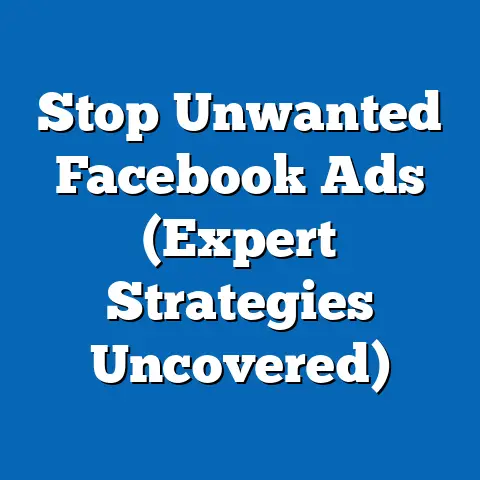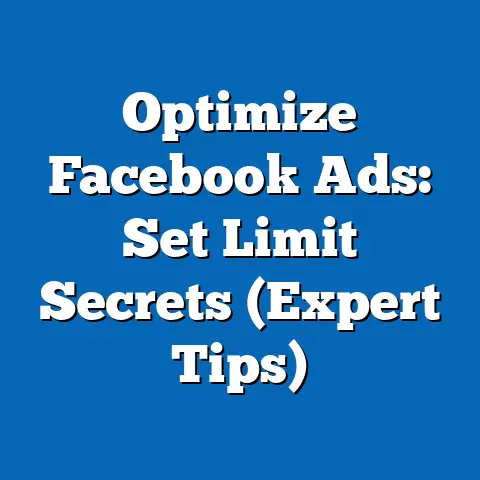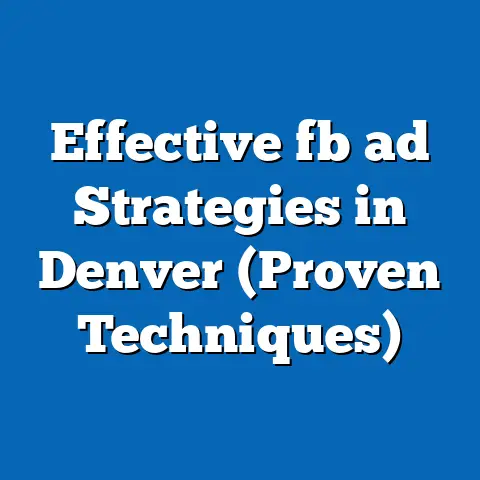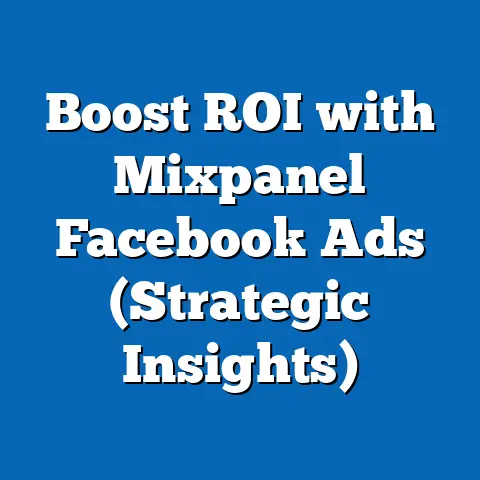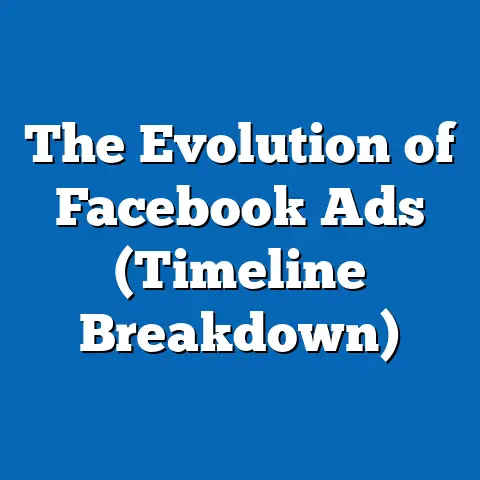Unlock Facebook Ads Audiences (Strategic Targeting Techniques)
Innovation. It’s a word that gets thrown around a lot, especially in the fast-paced world of digital marketing. But what does it really mean when we’re talking about Facebook Ads? For me, it’s about constantly pushing the boundaries of what’s possible, finding new ways to connect with the right people, and ultimately, driving better results.
The advertising landscape has changed dramatically. I remember when simply having a website was enough to stand out. Now, we’re bombarded with ads everywhere we look. Platforms like Facebook have revolutionized how we reach audiences, offering incredibly granular targeting options that were unimaginable just a decade ago. But with great power comes great responsibility (and a lot of competition!).
The key to success on Facebook Ads today is innovation. It’s about developing creative strategies to cut through the noise and reach your ideal customer. It’s about leveraging Facebook’s ever-evolving tools and features to connect with your target audience in a more meaningful and effective way. This isn’t just about setting up a basic campaign; it’s about constantly testing, learning, and adapting to the changing landscape.
In this guide, I’m going to walk you through how to unlock the full potential of Facebook Ads audiences through strategic targeting techniques. I’ll cover everything from the fundamentals of Facebook’s targeting capabilities to advanced strategies that will help you refine your audience selection and improve your ROI. Let’s dive in!
1. Understanding Facebook’s Audience Targeting Capabilities
Facebook’s audience targeting is, in my opinion, one of its most powerful assets. It allows you to reach a specific group of people who are most likely to be interested in your products or services. But to truly harness its power, you need to understand the different targeting options available.
Here’s a breakdown of the core targeting features:
- Demographic Targeting: This is the foundation of most Facebook Ads campaigns. It allows you to target users based on attributes like age, gender, education, location, job title, relationship status, and more. I’ve found that even with broad demographics, you can start seeing some interesting trends. For example, if I’m selling a course on digital marketing, I might initially target people aged 25-45 with a college degree who are interested in marketing and advertising.
- Interest Targeting: This feature lets you target users based on their interests, hobbies, and the pages they’ve liked on Facebook. This is where you can really start to get specific. Are you selling hiking gear? Target people interested in hiking, camping, outdoor recreation, and specific hiking trails. I often experiment with layering different interests to see which combinations perform best.
- Behavior Targeting: This option allows you to target users based on their purchase behavior, device usage, travel habits, and other activities on and off Facebook. This is incredibly powerful for reaching people who are actively in the market for what you’re selling. For example, you can target people who have recently purchased products online, travel frequently, or use specific mobile devices.
These features can be combined to create highly specific audiences. However, the real magic happens when you start using Custom Audiences and Lookalike Audiences.
Custom Audiences: Reaching Your Existing Customers
Custom Audiences allow you to target people who have already interacted with your business. This could include:
- Website Visitors: Target people who have visited specific pages on your website. This is perfect for retargeting people who abandoned their shopping carts or viewed product pages.
- Customer Lists: Upload a list of your existing customers (email addresses or phone numbers) and target them on Facebook.
- App Users: Target people who have downloaded and used your mobile app.
- Engagement Audiences: Target people who have interacted with your Facebook Page or Instagram profile, such as liking your posts, watching your videos, or attending your events.
I’ve had a lot of success with Custom Audiences. I once ran a campaign targeting people who had visited my website but hadn’t signed up for my email list. By offering them a free ebook, I was able to significantly increase my subscriber base.
Lookalike Audiences: Finding New Customers
Lookalike Audiences allow you to find new people who are similar to your existing customers. You can create a Lookalike Audience based on:
- Your Customer List: Facebook will analyze your customer list and find people who share similar demographics, interests, and behaviors.
- Website Visitors: Create a Lookalike Audience based on the people who have visited your website.
- Engagement Audiences: Create a Lookalike Audience based on people who have engaged with your Facebook Page or Instagram profile.
I’ve found that Lookalike Audiences are a great way to scale your campaigns and reach new customers who are likely to be interested in your products or services. I usually start by creating a 1% Lookalike Audience (the most similar to your source audience) and then gradually expand to 2%, 3%, and so on.
Key Takeaway: Understanding Facebook’s core targeting features, Custom Audiences, and Lookalike Audiences is essential for creating effective Facebook Ads campaigns. Experiment with different combinations of these features to find the audiences that perform best for your business.
Next Step: Start experimenting with creating Custom Audiences and Lookalike Audiences based on your existing customer data and website traffic.
2. The Importance of Data-Driven Targeting
In the old days, advertising was often based on gut feeling and intuition. But with Facebook Ads, you have access to a wealth of data that can inform your targeting decisions. Data-driven targeting means using data to understand your audience, optimize your campaigns, and improve your ROI.
Leveraging Facebook Insights and Audience Insights
Facebook Insights (now called Meta Business Suite Insights) provides data about your Facebook Page’s performance, including:
- Page Likes: Track the growth of your Page’s audience.
- Post Reach: See how many people are seeing your posts.
- Engagement: Measure how people are interacting with your posts (likes, comments, shares).
- Demographics: Understand the age, gender, and location of your Page’s audience.
This data can help you understand what type of content resonates with your audience and how to tailor your ads accordingly. For example, if you notice that your audience is primarily female and interested in fashion, you can create ads that showcase your latest women’s clothing collection.
Audience Insights, on the other hand, provides data about specific audiences you’re targeting with your ads. This tool allows you to:
- Analyze Demographics: Understand the age, gender, education, and location of your target audience.
- Explore Interests: Discover the interests, hobbies, and pages your target audience likes.
- Identify Behaviors: Learn about the purchase behavior, device usage, and travel habits of your target audience.
I find Audience Insights incredibly valuable for refining my targeting. I once used it to discover that my target audience was also interested in a specific brand of coffee. I then included that brand in my interest targeting, and my ad performance improved significantly.
Analyzing Audience Behavior, Preferences, and Demographics
The key to data-driven targeting is to analyze your audience’s behavior, preferences, and demographics and use that information to craft personalized ad campaigns. This means:
- Understanding Their Pain Points: What problems are your target audience facing? How can your product or service solve those problems?
- Knowing Their Motivations: What motivates your target audience to make a purchase? Are they looking for convenience, value, or status?
- Speaking Their Language: Use the same language and tone that your target audience uses. Avoid jargon and technical terms.
I always start by creating a customer persona. This is a fictional representation of your ideal customer, based on data and research. It helps you visualize your target audience and understand their needs and motivations.
For example, if I’m selling a productivity app, my customer persona might be “Sarah, a 30-year-old project manager who is struggling to keep track of her tasks and deadlines. She’s looking for a simple, easy-to-use app that can help her stay organized and productive.”
Once you have a customer persona, you can use that to guide your targeting decisions and create ad copy that resonates with your target audience.
Key Takeaway: Data-driven targeting is essential for creating effective Facebook Ads campaigns. Use Facebook Insights and Audience Insights to gather data about your audience and craft personalized ad campaigns that resonate with their needs and motivations.
Next Step: Use Audience Insights to analyze your existing customer base or a potential target audience. Identify their demographics, interests, and behaviors and use that information to refine your targeting.
3. Advanced Targeting Techniques
Now that you have a solid understanding of the fundamentals of Facebook’s targeting capabilities and the importance of data-driven targeting, let’s dive into some advanced techniques that can help you take your campaigns to the next level.
Layered Targeting: Precision Targeting
Layered targeting involves combining multiple targeting parameters to narrow down your audience and reach a more specific group of people. This is particularly useful when you have a niche product or service or when you want to target a very specific segment of your audience.
For example, let’s say you’re selling organic baby food. You could start by targeting parents with young children. But to narrow down your audience, you could add additional layers, such as:
- Interests: People interested in organic food, healthy eating, and natural parenting.
- Behaviors: People who have recently purchased baby products online.
- Demographics: Parents with a high level of education and income.
By combining these layers, you can reach a highly targeted audience of parents who are likely to be interested in your organic baby food.
I’ve found that layered targeting can significantly improve your ad performance. However, it’s important to be careful not to narrow your audience too much. If your audience is too small, your ads may not get enough impressions, and your results may suffer.
Retargeting Strategies: Engaging Warm Leads
Retargeting involves showing ads to people who have already interacted with your business. This is a highly effective strategy because these people are already familiar with your brand and are more likely to convert.
There are several ways to retarget people on Facebook:
- Website Retargeting: Show ads to people who have visited specific pages on your website. This is perfect for retargeting people who abandoned their shopping carts or viewed product pages.
- Video Retargeting: Show ads to people who have watched a certain percentage of your videos. This is a great way to re-engage people who have shown interest in your content.
- Engagement Retargeting: Show ads to people who have interacted with your Facebook Page or Instagram profile, such as liking your posts, watching your videos, or attending your events.
I always recommend setting up retargeting campaigns for your website visitors. It’s a relatively simple way to increase your conversion rates and drive more sales.
Seasonal Targeting: Capitalizing on Trends
Seasonal targeting involves adjusting your targeting based on seasonal trends and consumer behavior. This could include:
- Holidays: Target people who are shopping for holiday gifts.
- Back-to-School: Target parents who are shopping for school supplies.
- Summer: Target people who are planning summer vacations.
By aligning your targeting with seasonal trends, you can increase the relevance of your ads and improve your ad performance.
I once ran a campaign targeting people who were planning summer vacations. I showed them ads for my travel accessories, and my sales skyrocketed.
Geotargeting: Localized Marketing
Geotargeting allows you to target audiences based on specific geographic locations. This is particularly useful for businesses with a local presence, such as restaurants, retail stores, and service providers.
You can target people based on:
- Country: Target people in a specific country.
- Region: Target people in a specific region or state.
- City: Target people in a specific city.
- Zip Code: Target people in a specific zip code.
You can also use radius targeting to target people within a certain radius of your business.
I’ve found that geotargeting is essential for local businesses. It allows you to reach people who are most likely to visit your store or use your services.
Key Takeaway: Advanced targeting techniques like layered targeting, retargeting, seasonal targeting, and geotargeting can help you refine your audience selection and improve your ad performance. Experiment with these techniques to find what works best for your business.
Next Step: Implement at least one of these advanced targeting techniques in your next Facebook Ads campaign. Monitor your results and adjust your strategy as needed.
4. Utilizing Facebook’s Ad Tools for Enhanced Targeting
Facebook provides a suite of advertising tools that can help you enhance your targeting and optimize your campaigns. Let’s take a look at some of the most important tools.
Ads Manager: The Central Hub
Ads Manager is the central hub for creating and managing your Facebook Ads campaigns. It provides a user-friendly interface for setting up your campaigns, defining your targeting parameters, creating your ads, and tracking your results.
With Ads Manager, you can:
- Choose Your Campaign Objective: Select the objective that aligns with your business goals, such as website traffic, lead generation, or sales.
- Define Your Audience: Use the targeting options discussed earlier to define your target audience.
- Set Your Budget and Schedule: Determine how much you want to spend on your campaign and when you want it to run.
- Create Your Ads: Design your ads with compelling visuals and persuasive copy.
- Track Your Results: Monitor your campaign’s performance and make adjustments as needed.
I spend a lot of time in Ads Manager, constantly tweaking my campaigns and experimenting with different targeting options.
Audience Insights Tool: Deep Dive into Your Audience
As mentioned earlier, the Audience Insights tool allows you to extract valuable insights from your audience for segmentation. It helps you understand their demographics, interests, behaviors, and more.
You can use this tool to:
- Identify Potential Targeting Options: Discover new interests and behaviors that you may not have considered before.
- Understand Your Audience’s Preferences: Learn what type of content resonates with your audience.
- Create More Personalized Ads: Craft ads that speak directly to your audience’s needs and motivations.
I always use Audience Insights before launching a new campaign to ensure that my targeting is as accurate as possible.
Dynamic Ads: Personalized Product Recommendations
Dynamic Ads use Facebook’s algorithms to target users with personalized product recommendations based on their previous interactions with your website or app.
For example, if someone viewed a specific product on your website, they might see an ad for that product on Facebook. Or if someone added a product to their shopping cart but didn’t complete the purchase, they might see an ad reminding them to complete their order.
Dynamic Ads are highly effective because they show people products they’re already interested in. They can significantly increase your conversion rates and drive more sales.
To use Dynamic Ads, you need to upload a product catalog to Facebook and set up a tracking pixel on your website.
Key Takeaway: Facebook’s Ad Tools, including Ads Manager, Audience Insights Tool, and Dynamic Ads, can help you enhance your targeting and optimize your campaigns. Use these tools to gather data, refine your targeting, and create personalized ads that resonate with your audience.
Next Step: Explore Facebook’s Ads Manager and Audience Insights tool. Familiarize yourself with the features and functionalities of each tool.
5. Case Studies and Examples
Let’s take a look at some real-life case studies of brands that have successfully used innovative targeting techniques in their Facebook Ads campaigns.
Case Study 1: Dollar Shave Club
Dollar Shave Club is a subscription service that delivers razors and grooming products to its customers’ doors. They used Facebook Ads to acquire new customers and grow their business.
Strategy: Dollar Shave Club used a combination of demographic targeting, interest targeting, and retargeting to reach their target audience. They targeted men aged 18-35 who were interested in grooming, shaving, and personal care. They also retargeted people who had visited their website but hadn’t signed up for a subscription.
Results: Dollar Shave Club’s Facebook Ads campaigns were highly successful, helping them acquire new customers at a low cost and grow their business rapidly.
Key Takeaway: Dollar Shave Club’s success demonstrates the power of combining different targeting techniques and retargeting to reach your ideal customer.
Case Study 2: Airbnb
Airbnb is a platform that allows people to rent out their homes or apartments to travelers. They used Facebook Ads to drive bookings and increase brand awareness.
Strategy: Airbnb used geotargeting to target travelers in specific locations. They showed them ads for listings in those locations, highlighting the unique features and amenities of each property. They also used Lookalike Audiences to find new travelers who were similar to their existing customers.
Results: Airbnb’s Facebook Ads campaigns were highly effective, helping them drive bookings and increase brand awareness among travelers around the world.
Key Takeaway: Airbnb’s success demonstrates the power of geotargeting and Lookalike Audiences for reaching specific audiences and driving conversions.
Case Study 3: Warby Parker
Warby Parker is an online retailer that sells eyeglasses and sunglasses. They used Facebook Ads to drive traffic to their website and increase sales.
Strategy: Warby Parker used a combination of demographic targeting, interest targeting, and retargeting to reach their target audience. They targeted people aged 25-45 who were interested in fashion, style, and eyewear. They also retargeted people who had visited their website but hadn’t made a purchase.
Results: Warby Parker’s Facebook Ads campaigns were highly successful, helping them drive traffic to their website and increase sales.
Key Takeaway: Warby Parker’s success demonstrates the power of using a consistent brand message and high-quality visuals in your Facebook Ads.
Key Takeaway: These case studies highlight the importance of understanding your target audience, using the right targeting techniques, and creating compelling ads that resonate with your audience.
Next Step: Analyze these case studies and identify the key takeaways that you can apply to your own Facebook Ads campaigns.
Conclusion: The Future of Targeting on Facebook
As you’ve seen, strategic targeting is essential for achieving success with Facebook Ads. By understanding Facebook’s targeting capabilities, leveraging data-driven insights, and implementing advanced targeting techniques, you can reach the right people, drive conversions, and improve your ROI.
The strategies I’ve discussed can help you stay ahead in the competitive landscape of Facebook advertising. But it’s important to remember that the platform is constantly evolving. New features and targeting options are being introduced all the time.
Looking ahead, I believe that AI and machine learning will play an even bigger role in audience targeting on Facebook. These technologies will allow advertisers to create even more personalized and effective campaigns.
Innovation in targeting is crucial for achieving better ROI and connecting with audiences in more meaningful ways. By staying up-to-date with the latest trends and technologies, you can ensure that your Facebook Ads campaigns are always performing at their best.
Key Takeaway: Innovation in targeting is crucial for achieving better ROI and connecting with audiences in more meaningful ways.
Next Step: Stay up-to-date with the latest trends and technologies in Facebook advertising. Experiment with new targeting options and strategies to find what works best for your business.
I hope this guide has provided you with valuable insights and practical techniques for unlocking the potential of Facebook Ads audiences through strategic targeting. Remember, the key is to constantly test, learn, and adapt to the changing landscape. Good luck!

